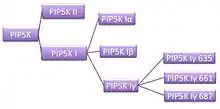Phosphatidylinositol-4-phosphate 5-kinase
Phosphatidylinositol-4-phosphate 5-kinases (PIP5Ks, or PI4P5Ks) are a class of enzymes that phosphorylate phosphatidylinositol 4-phosphate. They perform this reaction on the fifth hydroxyl of the myo-inositol ring to form phosphatidylinositol 4,5-bisphosphate.
Function

P2.jpg.webp)
Phosphatidylinositol 4-Phosphate-5 kinase (PI4P5K) or PIP5K or PI5K family regulates diverse cellular processes such as G protein-coupled receptor(GPCR) signaling, vesicle trafficking, chemotaxis and cellular movement.[1][2][3] There are at least two types of PIP5K found which includes Type I and Type II. Other types are also suspected in the nervous system but have not been well reported. These enzyme synthesize diverse Phosphatidyl Inositol 4,5 bisphosphate ( PI(4,5)P2 ) by phosphorylating the D- 5 position of the inositol ring of Phosphatidylinositol 4-phosphate[3]]. PIP5KI is the most extensively studied and is synthesizing for most of the PI(4,5)P2 pool the cell.[1][3]
Both Type I and Type II phosphatidylinositol-4-phosphate 5-kinase (PIP5KI) are further classified as PIP5Kα, PIP5Kβ and PIP5Kγ on the basis of their basic differences in primary structure and the variation in the expression level in different compartment of cells, indicating that individual PIP5KI isoform has non identical function [5]. Moreover, PIP5Kγ, has three splicing variance; PIP5Kγ635, PIP5γ661, and PIP5Kγ687, making it one of the key regulators for producing PI(4,5)P2 that plays a role in diverse cellular processes.[4]
Although an extensive study to elucidate the role of PI(4,5)P2 and PIP5 kinase has been focused on many cellular processes such as vesicle trafficking, cell movement and cytoskeletal assembly, a very few studies have been reported for their role in neuronal development. PIP5K is highly expressed kinase in the nervous system of several organisms and plays important role in neuronal development including embryogenesis and post-natal neural development.[5] The disruption of PIP5KIγ leads to broad developmental and cellular defects in mice indicating PIP5KIγ plays critical role for embryogenesis and adulthood of mice and its disruption causes fatality for postnatal life [[6]]. The embryo without PIP5KIγ has extensive prenatal lethality during embryonic development. The disruption of PIP5KIγ also causes neural tube closure defects caused by decreased PI(4,5)P2 level.[5][7] In contrast to this, mice lacking PIPKIα or PIPKIβ have major impact during adulthood but no effect in prenatal embryo, Even in the absence of both PIPKIα and PIPKIβ, a single allele of PIPKIγ, can support normal the adulthood functioning, indicating PIPKIγ and PIPKIα have partially overlapping function during embryogenesis.[6][7] In different experiments, the role of PIP5K in neurite outgrowth has been analyzed by knocking down PIP5Kα. The Nerve Growth Factor (NGF) induced neurite outgrowth was more obvious in knock down cells than in control cells. In contrary, the over-expression of PIP5Ka in to a PIP5Ka Knock down cells abrogated neurite outgrowth showing PIP5K acts as a negative regulator of NGF-induced neurite outgrowth through inhibiting the PI3K/ AKT signaling pathway in PC12 cells.[8]
A novel mechanism for the role of PIPKIα in regulating neuronal morphology by controlling microtubule dynamics is reported in mouse. During axon pathfinding, a growth cone is formed to guide the migrating axon. Growth cone formation is induced by Kinesin Supar Family protein 2A (KIF2A) KIF2A- mediated depolymerization of microtubules. The interaction of PIPKα with KIF2A suppresses the elongation of axon branches.[9]
In association with Daam2, PIP5 kinase promotes Wnt signaling and receptor complex formation which is required for the regenerative myelination of the neuron. In the central nervous system (CNS) of chick, PIP5K-PI(4,5)P2 mediated role of Daam2 has been reported for the development of neurons.[10]
List of PIP4Ks
References
- Loijens, JC; Boronenkov, IV; Parker, GJ; Anderson, RA (1996). "The phosphatidylinositol 4-phosphate 5-kinase family". Adv. Enzyme Regul. 36: 115–40. doi:10.1016/0065-2571(95)00005-4. PMID 8869744.
- Honda, A; Nogami, M; Yokozeki, T; et al. (November 1999). "Phosphatidylinositol 4-phosphate 5-kinase alpha is a downstream effector of the small G protein ARF6 in membrane ruffle formation". Cell. 99 (5): 521–32. doi:10.1016/s0092-8674(00)81540-8. PMID 10589680. S2CID 10031591.
- Doughman, RL; Firestone, AJ; Anderson, RA (2003). "Phosphatidylinositol phosphate kinases put PI4,5P(2) in its place". J. Membr. Biol. 194 (2): 77–89. doi:10.1007/s00232-003-2027-7. PMID 14502432. S2CID 20687896.
- Sun, Yue; Thapa, Narendra; Hedman, Andrew C.; Anderson, Richard A. (2013-06-01). "Phosphatidylinositol 4,5-bisphosphate: targeted production and signaling". BioEssays. 35 (6): 513–522. doi:10.1002/bies.201200171. ISSN 1521-1878. PMC 3882169. PMID 23575577.
- Di Paolo, Gilbert; Moskowitz, Howard S.; Gipson, Keith; Wenk, Markus R.; Voronov, Sergey; Obayashi, Masanori; Flavell, Richard; Fitzsimonds, Reiko M.; Ryan, Timothy A. (2004-09-23). "Impaired PtdIns(4,5)P2 synthesis in nerve terminals produces defects in synaptic vesicle trafficking". Nature. 431 (7007): 415–422. doi:10.1038/nature02896. ISSN 1476-4687. PMID 15386003. S2CID 4333681.
- Volpicelli-Daley, Laura A.; Lucast, Louise; Gong, Liang-Wei; Liu, Lijuan; Sasaki, Junko; Sasaki, Takehiko; Abrams, Charles S.; Kanaho, Yasunori; De Camilli, Pietro (2010-09-10). "Phosphatidylinositol-4-phosphate 5-kinases and phosphatidylinositol 4,5-bisphosphate synthesis in the brain". The Journal of Biological Chemistry. 285 (37): 28708–28714. doi:10.1074/jbc.M110.132191. ISSN 1083-351X. PMC 2937898. PMID 20622009.
- Wang, Yanfeng; Lian, Lurong; Golden, Jeffrey A.; Morrisey, Edward E.; Abrams, Charles S. (2007-07-10). "PIP5KIγ is required for cardiovascular and neuronal development". Proceedings of the National Academy of Sciences of the United States of America. 104 (28): 11748–11753. doi:10.1073/pnas.0700019104. ISSN 0027-8424. PMC 1913884. PMID 17609388.
- Liu, T; Lee, SY (2013). "Phosphatidylinositol 4-phosphate 5-kinase α negatively regulates nerve growth factor-induced neurite outgrowth in PC12 cells". Exp. Mol. Med. 45 (3): e16. doi:10.1038/emm.2013.18. PMC 3641393. PMID 23538529.
- Noda, Y; Niwa, S; Homma, N; Fukuda, H; Imajo-Ohmi, S; Hirokawa, N (2012). "Phosphatidylinositol 4-phosphate 5-kinase alpha (PIPKα) regulates neuronal microtubule depolymerase kinesin, KIF2A and suppresses elongation of axon branches". Proc. Natl. Acad. Sci. U.S.A. 109 (5): 1725–30. doi:10.1073/pnas.1107808109. PMC 3277188. PMID 22307638.
- Lee, HK; Chaboub, LS; Zhu, W; Zollinger, D; Rasband, MN; Fancy, SP; Deneen, B (2015). "Daam2-PIP5K is a regulatory pathway for Wnt signaling and therapeutic target for remyelination in the CNS". Neuron. 85 (6): 1227–43. doi:10.1016/j.neuron.2015.02.024. PMC 4402944. PMID 25754822.